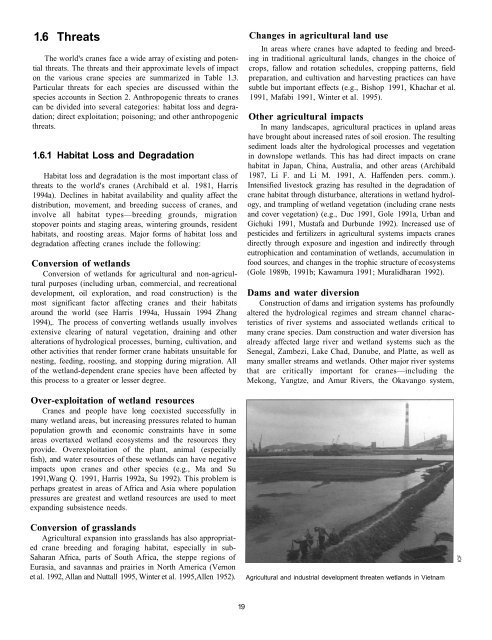The Cranes IUCN
The Cranes IUCN
The Cranes IUCN
You also want an ePaper? Increase the reach of your titles
YUMPU automatically turns print PDFs into web optimized ePapers that Google loves.
1.6 Threats<br />
<strong>The</strong> world's cranes face a wide array of existing and potential<br />
threats. <strong>The</strong> threats and their approximate levels of impact<br />
on the various crane species are summarized in Table 1.3.<br />
Particular threats for each species are discussed within the<br />
species accounts in Section 2. Anthropogenic threats to cranes<br />
can be divided into several categories: habitat loss and degradation;<br />
direct exploitation; poisoning; and other anthropogenic<br />
threats.<br />
1.6.1 Habitat Loss and Degradation<br />
Habitat loss and degradation is the most important class of<br />
threats to the world's cranes (Archibald et al. 1981, Harris<br />
1994a). Declines in habitat availability and quality affect the<br />
distribution, movement, and breeding success of cranes, and<br />
involve all habitat types—breeding grounds, migration<br />
stopover points and staging areas, wintering grounds, resident<br />
habitats, and roosting areas. Major forms of habitat loss and<br />
degradation affecting cranes include the following:<br />
Conversion of wetlands<br />
Conversion of wetlands for agricultural and non-agricultural<br />
purposes (including urban, commercial, and recreational<br />
development, oil exploration, and road construction) is the<br />
most significant factor affecting cranes and their habitats<br />
around the world (see Harris 1994a, Hussain 1994 Zhang<br />
1994),. <strong>The</strong> process of converting wetlands usually involves<br />
extensive clearing of natural vegetation, draining and other<br />
alterations of hydrological processes, burning, cultivation, and<br />
other activities that render former crane habitats unsuitable for<br />
nesting, feeding, roosting, and stopping during migration. All<br />
of the wetland-dependent crane species have been affected by<br />
this process to a greater or lesser degree.<br />
Over-exploitation of wetland resources<br />
<strong>Cranes</strong> and people have long coexisted successfully in<br />
many wetland areas, but increasing pressures related to human<br />
population growth and economic constraints have in some<br />
areas overtaxed wetland ecosystems and the resources they<br />
provide. Overexploitation of the plant, animal (especially<br />
fish), and water resources of these wetlands can have negative<br />
impacts upon cranes and other species (e.g., Ma and Su<br />
1991,Wang Q. 1991, Harris 1992a, Su 1992). This problem is<br />
perhaps greatest in areas of Africa and Asia where population<br />
pressures are greatest and wetland resources are used to meet<br />
expanding subsistence needs.<br />
Conversion of grasslands<br />
Agricultural expansion into grasslands has also appropriated<br />
crane breeding and foraging habitat, especially in sub-<br />
Saharan Africa, parts of South Africa, the steppe regions of<br />
Eurasia, and savannas and prairies in North America (Vernon<br />
et al. 1992, Allan and Nuttall 1995, Winter et al. 1995,Allen 1952).<br />
19<br />
Changes in agricultural land use<br />
In areas where cranes have adapted to feeding and breeding<br />
in traditional agricultural lands, changes in the choice of<br />
crops, fallow and rotation schedules, cropping patterns, field<br />
preparation, and cultivation and harvesting practices can have<br />
subtle but important effects (e.g., Bishop 1991, Khachar et al.<br />
1991, Mafabi 1991, Winter et al. 1995).<br />
Other agricultural impacts<br />
In many landscapes, agricultural practices in upland areas<br />
have brought about increased rates of soil erosion. <strong>The</strong> resulting<br />
sediment loads alter the hydrological processes and vegetation<br />
in downslope wetlands. This has had direct impacts on crane<br />
habitat in Japan, China, Australia, and other areas (Archibald<br />
1987, Li F. and Li M. 1991, A. Haffenden pers. comm.).<br />
Intensified livestock grazing has resulted in the degradation of<br />
crane habitat through disturbance, alterations in wetland hydrology,<br />
and trampling of wetland vegetation (including crane nests<br />
and cover vegetation) (e.g., Duc 1991, Gole 1991a, Urban and<br />
Gichuki 1991, Mustafa and Durbunde 1992). Increased use of<br />
pesticides and fertilizers in agricultural systems impacts cranes<br />
directly through exposure and ingestion and indirectly through<br />
eutrophication and contamination of wetlands, accumulation in<br />
food sources, and changes in the trophic structure of ecosystems<br />
(Gole 1989b, 1991b; Kawamura 1991; Muralidharan 1992).<br />
Dams and water diversion<br />
Construction of dams and irrigation systems has profoundly<br />
altered the hydrological regimes and stream channel characteristics<br />
of river systems and associated wetlands critical to<br />
many crane species. Dam construction and water diversion has<br />
already affected large river and wetland systems such as the<br />
Senegal, Zambezi, Lake Chad, Danube, and Platte, as well as<br />
many smaller streams and wetlands. Other major river systems<br />
that are critically important for cranes—including the<br />
Mekong, Yangtze, and Amur Rivers, the Okavango system,<br />
Agricultural and industrial development threaten wetlands in Vietnam<br />
ICF

















